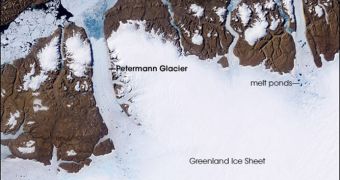Greenland has just lost a massive chunk of ice from its Petermann Glacier, experts report. The structure, which is an estimated four time the size of Manhattan, is now floating freely in the Atlantic Ocean. According to scientists, this is the first time since 1962 that such a massive piece of ice breaks loose, and they blame global warming for this event. The Glacier lost about 25 percent of its surface, as revealed by observations conducted from satellites. The ice shelf is located about 1,000 kilometers (620 miles) south of the North Pole, OurAmazingPlanet reports.
“In the early morning hours of August 5, 2010, an ice island four times the size of Manhattan was born in northern Greenland,” announces University of Delaware associate professor of physical ocean science and engineering Andreas Muenchow. The Petermann Glacier is located at abot 81 degrees north latitude and 61 degrees west longitude, and it use to consist of a floating ice shelf some 70 kilometers, or 43 miles, long. The shelf is now only 75 percent its former size, the latest satellite data indicate.
“The freshwater stored in this ice island could keep the Delaware or Hudson rivers flowing for more than two years. It could also keep all US public tap water flowing for 120 days,” Muenchow sys of the massive iceberg. He adds that the break was found at around 8:40 UTC (4:40 EDT) on August5, a few hours after the NASA-operated MODIS-Aqua satellite snapped photos of the location. The event was discovered by Canadian Ice Service expert Trudy Wohlleben.
What makes this discovery very concerning is the fact that the Petermann Glacier is one of two remaining glaciers that still retain floating shelves at the points were they spill into the sea. The impressive ice sheet covering Greenland is connected directly to the Atlantic through these floating shelves, experts say. They add that the newly-formed ice island has a surface of about 100 square miles (260 square kilometers), and that it can reach a thickness of up to 220 meters. It is currently heding for the waterway connecting northern Greenland to Canada, called the Nares Strait.
“In Nares Strait, the ice island will encounter real islands that are all much smaller in size. The newly born ice-island may become land-fast, block the channel, or it may break into smaller pieces as it is propelled south by the prevailing ocean currents. From there, it will likely follow along the coasts of Baffin Island and Labrador, to reach the Atlantic within the next two years,” Muenchow concludes.

 14 DAY TRIAL //
14 DAY TRIAL //